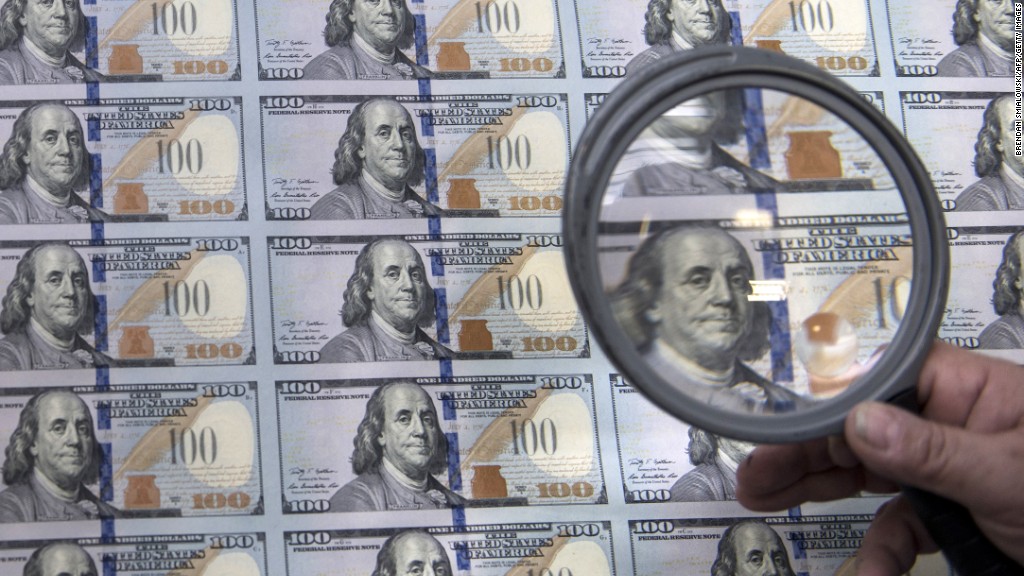
Donald Trump says don't worry, America will always be able to pay its debts because the government can simply print more money.
"This is the United States government. First of all, you never have to default because you print the money," Trump told CNN's Chris Cuomo on "New Day" Monday.
So how exactly do you print money?
At the most basic level, the Bureau of Engraving and Printing prints America's paper money and the U.S. Mint makes the coins. Both agencies are part of the U.S. Treasury. You can see the money-making in person if you take a tour or watch it online. It's a big printing machine that looks a lot like the printers used for a newspaper or school yearbook.
Related: Who exactly holds U.S. debt?
How the U.S. actually prints money
But the president isn't the one who gets to flip the switch on the money-printing machines. Only the Federal Reserve -- America's independent central bank -- can instruct the Bureau of Engraving and the U.S. Mint to print more money.
Typically, the Fed makes one phone call a year to the Bureau of Engraving with a request for more money to be printed. The latest call was made in July 2015 when the Fed ordered a little bit over $213 billion of new currency, which included a mix of dollar bills, $5 bills, $10 bills, $20 bills, etc.
The Fed has two goals when it makes that annual order: first, it has to replace bills that are destroyed because they are no longer usable (e.g. when people draw on them or cut them up). Second, the Fed anticipates how much additional cash will be needed as the economy grows.
Related: Why Donald Trump's debt proposal is reckless
'Printing money' is more than physical dollars
But when Trump or anyone else talks about "printing money," they usually don't mean manufacturing new bills and coins.
Physical dollars and coins are only a small part -- about 10% -- of the "money supply" in the economy. The other 90% is in electronic form in checking and savings accounts at banks. Currently, the U.S. money supply is about $12.7 trillion.
Instead of printing more physical dollars, it's quicker for the Fed to get money into the economy by purchasing assets such as bonds from a bank. The Fed pays the banks dollars in exchange for the assets.
Related: Donald Trump: 'I'm the king of debt'
The Fed has been doing a lot of this
In that sense, the Fed has been "printing a lot of money" since the Great Recession by buying bonds from banks. The tactic has been dubbed "quantitative easing."
The idea was to get more money into the bank vaults and grease the financial system. In 2008 and 2009, the financial crisis was exacerbated by the fact that many big banks didn't have enough cash on hand to make good on what they owed others. To get money flowing, the Fed had to step in.
The hope was the extra money would make banks healthier and then they would start lending more to Main Street. That second part of the equation didn't happen as much as policymakers desired. It's one of the reasons there hasn't been much inflation, the usual demon that comes along with printing money.
Related: Should investors fear President Trump or Clinton?
Why printing money is a bad idea
In economics classes, professors teach students that printing money is a bad idea. Why? Because when a government prints more money, it usually makes the money already in existence worth less.
Think about it like a pizza being divided up into even more slices. It won't take long for people to realize that they need more of the new, smaller slices to equal one old slice.
Stores soon start charging more goods. A gallon of milk may jump from $3 to $5. It's what economists call inflation.
"Zimbabwe is the prime example of how bad things can get," says Wellesley College professor Dan Sichel, an economist who used to work at the Federal Reserve and U.S. Treasury.
Related: Has the Fed messed up?
America doesn't want to become Zimbabwe
Zimbabwe printed so much money that prices shot up almost exponentially in the country (e.g. bread suddenly cost over a trillion Zimbabwe dollars). The currency basically became worthless in 2009 and the economy tanked.
The fear about Trump's comment is that as president he would a) try to force the Fed to expand the money supply. That would harm the independence of America's policy setting central bank. And b) that Trump would print money for the sole reason that the government didn't have enough money to pay its bills.
Printing money solely to fund the government is very different than what the Fed has been trying to do with getting more money to banks to boost lending and economic growth, according to economist Doug Holtz-Eakin, a former advisor to John McCain's 2008 presidential campaign.
Trump's comment implied he would do something akin to the Zimbabwe-style money printing.
The U.S. has a long way to go to get to that point, but even heading down that path would send shock waves through global markets.


